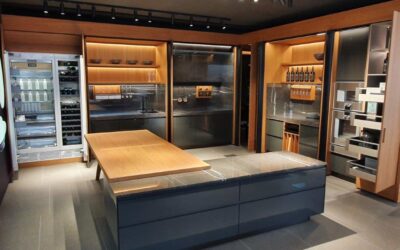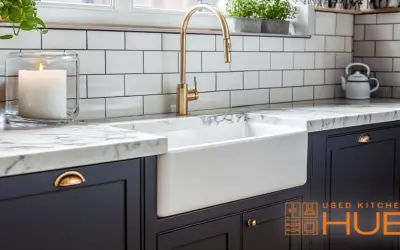5 Mistakes to Avoid When Selling Your Used Kitchen
Introduction
Disposing of or selling a pre-loved kitchen, whether it’s an ex-display model or a long-term rental fit-out, offers strong returns and promotes sustainable reuse. However, many sellers underestimate the complexity. Whether it’s setting a reserve price or preparing the necessary documentation, each misstep can either lower your return or extend your timeline.
To avoid the common kitchen sale mistakes that catch out even seasoned landlords and High Net Worth (HNW) individuals, you’ll need to steer clear of five key errors. These include underpricing pitfalls, photo staging tips, listing errors, negotiation mistakes, and failing to provide a proper documentation guide. Addressing these will help maximise your value, reduce delays, and ensure a seamless transaction.
Mistake 1: Underpricing Pitfalls
Failing to establish an accurate market value is one of the costliest mistakes. Underpricing pitfalls can mean leaving significant money on the table and even shaking buyer confidence if subsequent offers are higher based on better-aligned market comparables.
This issue often arises from incomplete research. Sellers sometimes rely on instinct rather than examining similar listings of high-end or ex-display kitchens currently on the market. Overlooking issues like surface wear, fading, or the age of appliances can also distort perceived value. In some cases, sellers under pressure to vacate a space, reduce pricing too quickly, which weakens their position during negotiation.
To avoid underpricing, it’s best to start with a professional valuation. A resale expert can benchmark your kitchen by considering brand, layout, upgrades, and condition, using actual sales data. Review at least five comparable listings, paying attention to both asking and sold prices. Keep in mind that buyers will factor in reconditioning or fitting costs, so presenting your kitchen in top condition helps retain your full value.
A strong valuation & selling strategy sets the right expectations and helps attract qualified buyers. If you’re unsure of your kitchen’s worth, our resale experts can assess your layout, brand, and finish against real market trends. Request your complimentary valuation before listing.
Mistake 2: Listing Errors
Your listing is the first impression, and errors here can lose you the sale. Listing errors, like vague descriptions or missing key details, invite confusion, reduce buyer trust, and often attract below-market offers.
Many sellers omit critical specs such as cabinet material, appliance brands, door styles, or worktop types. Inaccurate dimensions can result in wasted site visits or failed installs. Failing to disclose the kitchen’s showroom origin can also backfire later, creating friction during negotiations. Ambiguity about your removal timeline further complicates the buyer’s planning.
To avoid these pitfalls, use a structured documentation guide that covers layout measurements, materials, appliance models, warranties, and condition notes. Be clear about your removal window, including preferred dates and any access restrictions such as flat level or postcode-specific rules. If your kitchen is ex-display, be transparent and present it as a premium showroom clearance opportunity, highlighting its quality and value-for-money.
A complete and honest listing demonstrates professionalism and speeds up the sale.
Mistake 3: Skimping on Photo Staging Tips
A listing can be technically accurate but still underperform if the photos are poor. Quality imagery is essential, and applying solid photo staging tips will help you stand out in a crowded marketplace.
Photos matter because they shape first impressions, showcase design features, and help buyers visualise their own use of the space. Low-quality images, especially those with poor lighting or clutter, reduce perceived value. For HNW buyers, this visual disconnect can quickly be a dealbreaker.
Begin by decluttering the space. Remove all magnets, dishes, and personal items to create clean surfaces that accentuate the kitchen’s layout and materials. Shoot during the day using natural light, avoiding artificial lighting that may distort colours. Focus on standout features such as integrated appliances, bespoke joinery, or breakfast islands. Show adjacent spaces like utility rooms or pantries to highlight usability. Finally, use a wide-angle lens or smartphone panorama mode to capture the full layout clearly and accurately.
Well-staged photography supports your asking price and builds buyer confidence. That’s why every kitchen listed with Used Kitchen Hub includes a free professional photo shoot, no cost, no hassle. List with us to have your kitchen expertly captured, beautifully presented, and ready to sell fast.
Mistake 4: Negotiation Mistakes
Even the best-priced and most beautifully presented kitchen can fall apart if negotiation is poorly handled. Negotiation mistakes usually happen when sellers aren’t prepared, fail to set expectations, or ignore the motivations of their buyers.
Opening the conversation with vague signals like “best offer considered” can invite underbids. Reacting too strongly to a low initial offer may prematurely end what could have been a promising negotiation. Failing to consider what motivates the buyer, whether it’s a tight renovation timeline or a desire for premium features, can limit your ability to find a win-win. Not disclosing costs, such as removal or transport fees, early in the process can also cause last-minute issues.
Set clear boundaries from the outset, knowing your minimum acceptable figure after all fees. Be ready to walk away from unsuitable offers without burning bridges. Tailor your terms by identifying whether your buyer is a time-pressed landlord or a design-focused homeowner. Always provide a full cost breakdown, including transport or permits, early on to avoid surprises later.
A transparent and professional negotiation approach strengthens buyer trust and increases your chances of closing on favourable terms.
Mistake 5: Overlooking Documentation Guide & Condition Report
Finalising a kitchen sale without a documentation guide and proper condition report opens the door to delays, disputes, or even legal complications. This is especially true in transactions involving professional or HNW buyers.
Paperwork provides security. A signed and dated condition report with supporting photos offers a shared record of what is being sold. You should also include ownership confirmation, outline VAT implications if applicable, and establish handover logistics in writing to help prevent disruption on removal day.
Begin by building a condition report that details the state of each cabinet, drawer, and worktop. Use categories such as “as new,” “minor wear,” or “needs repair,” and include corresponding images. Your sale contract should include the names of both parties, the agreed price, itemised inventory, payment terms, collection date, and a resolution clause. If warranties are transferable, provide the documents and get buyer sign-off. Lastly, issue a signed handover receipt confirming date, time, and acceptance of the kitchen’s condition.
Solid documentation safeguards both parties and ensures the transaction concludes smoothly.
Conclusion
Selling your used kitchen can be efficient and profitable when handled correctly. To create a seamless, high-value transaction:
Avoid underpricing pitfalls by using professional valuation and market comparisons.
Prevent listing errors with a structured documentation guide.
Enhance appeal using effective photo staging tips.
Steer clear of negotiation mistakes by setting clear expectations and understanding buyer goals.
Finalise the deal with a proper documentation guide & condition report.
When these steps are followed, you ensure a smooth and rewarding experience.
Used Kitchen Hub takes care of every stage of the journey. From valuation and listing to photography and logistics, we manage the process end to end. Start your kitchen sale journey and unlock the true value of your space today.
FAQs
1. What are common mistakes when selling a used kitchen?
The main issues include poor pricing, incomplete listings, low-quality photos, negotiation missteps, and missing documentation.
2. How should I stage photos of my kitchen?
Declutter all surfaces, use natural light, capture key features and layout, and include contextual images of surrounding spaces.
3. What pricing errors should I avoid?
Do not rely on gut instinct. Use a professional valuation and account for any repairs or removal costs when calculating your lowest acceptable price.
4. What negotiation tips can help me secure the best sale?
Establish your floor price, understand the buyer’s goals, stay calm, and share all potential costs up front to avoid disputes.
5. What documentation is needed to finalise the sale?
You’ll need a signed condition report, an itemised sale contract, any transferable warranties, and a dated handover receipt after removal.


